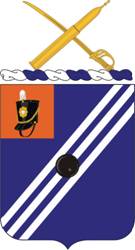
III Corps is a corps of the United States Army headquartered at Fort Hood, Texas. It is a major formation of the United States Army Forces Command.

The 5th Infantry Division (Mechanized)—nicknamed the "Red Diamond", or the "Red Devils" —was an infantry division of the United States Army that served in World War I, World War II and the Vietnam War, and with NATO and the U.S. Army III Corps. It was disbanded and deactivated on 24 November 1992.

Fort Devens is an inactive United States Army military installation in the towns of Ayer and Shirley, in Middlesex County and Harvard in Worcester County in the U.S. state of Massachusetts. It was named after jurist and Civil War general Charles Devens. The nearby Devens Reserve Forces Training Area is located in Lancaster. Although closed in 1996, the fort was reopened the next day as the Devens Reserve Forces Training Area. The name reverted to Fort Devens in May 2007.

The 9th Infantry Division is an inactive infantry division of the United States Army. It was created as the 9th Division during World War I, but never deployed overseas. In later years, it would become an important unit of the U.S. Army during World War II and the Vietnam War. It was also activated as a peacetime readiness unit from 1947 to 1962 at Fort Dix, New Jersey, and Fort Carson, Colorado, and from 1972 to 1991 as an active-duty infantry division at Fort Lewis, Washington. Nicknamed the "Old Reliables", the division was eventually inactivated in December 1991.

Fort Huachuca is a United States Army installation, established on 3 March 1877 as Camp Huachuca. The garrison is now under the command of the United States Army Installation Management Command. It is located in Cochise County, in southeast Arizona, approximately 15 miles (24 km) north of the border with Mexico and at the northern end of the Huachuca Mountains, adjacent to the town of Sierra Vista. From 1913 to 1933, the fort was the base for the "Buffalo Soldiers" of the 10th Cavalry Regiment. During the build-up of World War II, the fort had quarters for more than 25,000 male soldiers and hundreds of WACs. In the 2010 census, Fort Huachuca had a population of about 6,500 active duty soldiers, 7,400 military family members, and 5,000 civilian employees. Fort Huachuca has over 18,000 people on post during the peak working hours of 0700 and 1600 on weekdays.

The 9th Cavalry Regiment is a parent cavalry regiment of the United States Army.

The 2nd Cavalry Division was a cavalry division of the United States Army.

The 1st Infantry Regiment is a regiment of the United States Army that draws its lineage from a line of post American Revolutionary War units and is credited with thirty-nine campaign streamers. The 1st Battalion, 1st Infantry is assigned as support to the United States Military Academy at West Point, New York and to furnish the enlisted garrison for the academy and the Stewart Army Subpost. 2nd Battalion, 1st Infantry Regiment is an infantry component serving with the 2nd Stryker Brigade, 2nd Infantry Division at Joint Base Lewis–McChord, Washington.

The 171st Infantry Brigade was an infantry brigade of the United States Army based at Fort Jackson, South Carolina. With a long history of serving, the brigade saw action during both World War I and World War II before it was inactivated in 1946. During the Cold War the brigade was once again activated for a period of ten years until again inactivated in 1972. In 2007 the brigade was reactivated as a training support unit and inactivated on 10 June 2016.

The 68th Armor Regiment was first activated in 1933 in the Regular Army as the 68th Infantry Regiment.

The 15th Cavalry Regiment is a cavalry regiment of the United States Army. It was one of the Expansion Units originally established for the Spanish–American War, but has been a general workhorse unit ever since.
The 67th Armored Regiment is an armored regiment in the United States Army. The regiment was first formed in 1929 in the Regular Army as the 2nd Tank Regiment (Heavy) and redesignated as the 67th Infantry Regiment in 1932. It first became the 67th Armor in 1940. The regiment participated in World War I, World War II, Desert Storm/Desert Shield, Operation Iraqi Freedom, Operation Enduring Freedom, Operation Spartan Shield, Operation Inherent Resolve, Operation Resolute Support, and Operation Freedom's Sentinel.

The 76th Field Artillery Regiment is a field artillery regiment of the United States Army. First formed as a cavalry regiment in 1916, the regiment was converted to field artillery in 1917, and served in Europe during World War I with the 3rd Division and as a separate battalion during World War II, as well as in peacetime at Fort Knox, KY, and Fort Devens, MA. Since 1959, the regiment has been a parent regiment under the Combat Arms Regimental System and the U.S. Army Regimental System, with regimental elements serving with the 3rd Infantry Division in Germany and Operation Iraqi Freedom, with the 7th Infantry Division in Korea, and in the Army Reserve. No regimental elements are currently active.

The 51st Infantry Regiment is a regiment of the United States Army first established in 1917.
The 62nd Air Defense Artillery Regiment is an Air Defense Artillery regiment in the United States Army. The lineages of some of the units that have been part of the 62nd Air Defense Artillery and its predecessors give the regiment campaign credit for the War of 1812.

The 1st Aviation Brigade commands three distinctly different battalions—the 1st Battalion, 13th Aviation Regiment; the 1st Battalion, 145th Aviation Regiment; and the 2nd Battalion, 13th Aviation Regiment, the former Unmanned Aircraft Systems Training Battalion at Fort Huachuca, Arizona.

The 40th Armor Regiment was an armored regiment of the United States Army until the inactivation of its last element, its 1st Battalion, in 1996. It was redesignated and reactivated in 2005 as the 40th Cavalry Regiment and assigned to the 4th Brigade Combat Team (Airborne), 25th Infantry Division.

The 525th Expeditionary Military Intelligence Brigade (Expeditionary) is a unit of the United States Army specializing in the acquisition and analysis of information with potential military value. On 28 October 2014, the unit was reflagged from the "525th Battlefield Surveillance Brigade" to an expeditionary military intelligence brigade, the first of its kind.

The 312th Cavalry Regiment was a cavalry unit of the United States Army during World War I and the interwar period. It was activated in early 1918 but broken up later that year to form new artillery units. The unit was recreated as an Oklahoma, Arizona, New Mexico, and Colorado Organized Reserve unit during the interwar period. It was converted into a signal aircraft warning regiment after the United States entered World War II.

The Signal Corps Band was a military band maintained by the United States Army and associated with the United States Army Signal Corps. It was activated in 1943 as the band of the 4th Engineer Amphibian Brigade and was posted to Fort Gordon, Georgia, for most of its existence. The band was inactivated in 2016.























